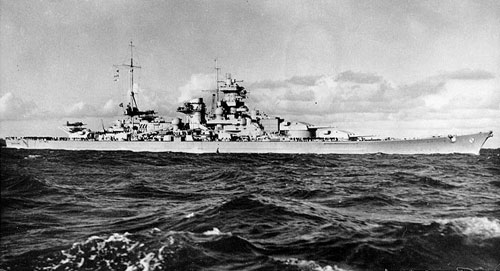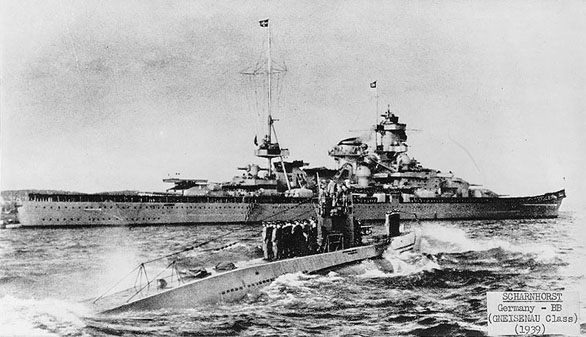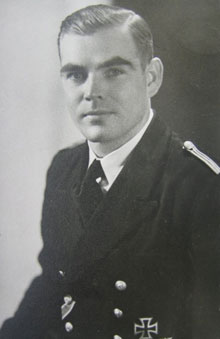The Eisenbart wolf-pack and the sinking of the Scharnhorst
by Alfred Jacobsen
The submarines of the Eisenbart group played a little known, but important part in the Battle of the North Cape. A careful analysis of the available sources shows that faulty navigation and communication difficulties contributed significantly to the German failure to find the convoy JW 55B and the subsequent loss of the famous battle cruiser Scharnhorst off the North Cape on Second Christmas Day 1943, writes the Norwegian author and TV-producer Alf R. Jacobsen, who in the year 2000 found and filmed the badly damaged wreck of the warship at a depth of 300 metres some 66 nautical miles to the north of the North Cape. This article is based on the revelations in his recent book "Scharnhorst", which has been published by Sutton in England and Ullstein in Germany.
When the convoy JW 55B was spotted by a Ju 88 weather plane at noon on Wednesday 22 December 1943, a little known, but well respected and educated German navy officer entered the centre stage. The 44-year old Kapitän-zur-See Rudolf Peters had spent most of his career on surface ships, most recently as First Officer of the battle cruiser Gneisenau (1940-42). He was considered to be a torpedo expert and had served many years as a torpedo instructor at the Naval Academy outside Kiel. Despite the fact that he never had commanded a submarine, he was in January 1943 appointed to the new post as Führer der Unterseeboote (FdU) Norwegen, with his headquarters on board Hitler`s former Führeryacht, Aviso Grille, which was moored alongside the captured 5 000 tons cruise-ship, Stella Polaris, in Narvik harbour - beyond the Arctic Circle. In December that same year, the admiral in charge of the First Battle Group in the huge Kaa fiord naval base even further to the north, Otto Klüber, was granted Christmas leave, and Peters was ordered to act as his stand-in. When the teleprinters clattered to life on board the Grille reporting the progress of convoy JW 55B a few days later, Peters had his moment. For a short, but fateful period in time he was both FdU and acting Admirals Nordmeer.

Battle cruiser Scharnhorst seen here in 1939.
U.S. Naval Historical Center Photograph.
Eight submarines
The Luftwaffe shadowed the convoy on its way north into worsening weather, while Peters mobilized the operational U-boats of the wolf-pack that some weeks earlier had been named Eisenbart. When the course and speed of the 19 merchantmen had been confirmed on Christmas Eve, all-in-all eight submarines were moving towards a patrol line 135 nautical miles to the southwest of Bear Island. They were U-277 (Lübsen), U-314 (Basse), U-354 (Herbschleb), U-387 (Büchler), U-601 (Hansen), U-636 (Hildebrandt), U-716 (Dunkelberg) and U-957 (Schaar).
"The boats will be in a position to get to grips with the convoy tomorrow morning," Peters noted in his war diary.
Some hours later, the 25-year old Oberleutnant zur See, Otto Hansen, on board the submerged U-601, picked up sounds that could not be mistaken - of propellers, valves and pumps at work. He waited till he considered the area safe, took the boat to the surface, and at 09.52 in the morning of Christmas Day 1943 dispatched the following signal to Peters in Narvik:
"Run over by convoy in AB6720. Enemy steering 60 degrees. Hansen."
The signal created feverish activity at the German command-posts at Kaafiord, Narvik and Kiel. When he replaced Raeder as C-in-C of the Kriegsmarine, Dönitz had persuaded the angry Führer not to break up his remaining capital ships, but form them into the powerful First Battle Group and move them to the Kaa fiord base, near the North Cape, only twelve hours sailing time from the convoy routes through the Barents Sea. The battleship Tirpitz was damaged, but Dönitz had already informed Hitler that he would strike against the next convoy with the 40 000 tons battle cruiser Scharnhorst and the five Narvik class destroyers of the 4th Flotilla. Hansen`s report confirmed that the 19 steamers, which carried some 200 000 tons of general cargo, ammunition and fuel for the Red Army, would pass within striking distance during the next twenty-four hours.
"In my opinion, and that of the Fleet Commander and Naval Staff, this was an excellent opportunity for the Scharnhorst," wrote Dönitz who ordered an attack to be carried out in the morning hours of Sunday, 26 December.
A violent storm
While the First Battle Group prepared to go to sea, the weather in the Bear Island area continued to deteriorate. A violent storm developed from the south-west with rain and showers of snow. The U-boats were tossed and pitched wildly in the mountainous seas.
"The weather worsens from hour to hour," wrote Hansen in his War Diary as he fought to remain in contact with the convoy. From time to time he could glimpse ships in the darkness, and twice he had to crash-dive to avoid being detected by searching escort vessels. A few miles away, another young skipper, the 25-year old Hans Dunkelberg of the newly commissioned U-716, also had a difficult time. After five hours of steaming on the surface, his drenched lookouts suddenly saw a destroyer some 3000 metres away. Dunkelberg turned his boat around and fired a T5 Gnat torpedo at the distant shadow. It turned out to be the opening shot of the Battle of the North Cape - and the only shot, as far as the submarines were concerned. "Am being run over by destroyer," Dunkelberg wrote in his KTB. "Because of the rough seas a miss was only to be expected. Now the throb of engines and turbines are audible at varying distances. The sounds are all fading away to the east."
At about the same time, a third of the Eisenbart submarines experienced a nightmare. On board the U-636, Kapitänleutnant Hans Hildebrandt had celebrated his thirty-third birthday on Christmas Eve. He picked up Otto Hansen's homing signals loud and clear and was about to turn his boat towards the position, when disaster struck. A succession of huge waves broke over the conning-tower and filled the boat with 15 tons of ice-cold seawater. The diesel engine stopped, and chlorine gas from the batteries started to build up. Fighting to restore the situation, Hildebrandt at 14.50 on Christmas Day signalled to Peters:
"Because of the presence of a lot of chlorine gas am only just able to dive. Am breaking off. Hammerfest."
After having restarted the engine and aired the boat, Hildebrandt set a course for FdU Norwegen's most forward base, the 5000 tons combined passenger and cargo ship, Black Watch, and the torpedo and supply carrier, Admiral Carl Hering, both of which were moored in the harbour of the coastal town, Hammerfest. On its slow and partly submerged passage towards U-stützpunkt Hammerfest, U-636 suddenly came across the convoy.
"At 1800-1920 in AB6496 run over by eight cargo vessels and three escorts. Easterly course, 70 rpm. No contact. Poor listening conditions. Visibilty 800 metres," Hildebrandt reported at 22 hours that evening. However, the careful skipper did not repeat his signal, which never reached FdU Peters, who in Narvik monitored the situation with increasing anxiety. The Scharnhorst and her five escorts had been under way for three hours, since leaving the base at 19 o`clock. The flotilla was heading into the storm and the Arctic darkness, and Peters knew from his U-boats how difficult the situation had become. He appealed to his superiors in Kiel and Berlin to cancel the attack, but to no avail. Dönitz had promised Hitler a victory, and would not budge.
"I have confidence in your will to fight. Heil Hitler!" the Grand Admiral signalled the First Battle Group at midnight.
The strange signal
After a hard night, battling the wind and heavy seas, the Scharnhorst and her destroyers reached the battleground some fifty miles to the south of Bear Island in the early morning hours of 26 December. When the flotilla turned west and started to search for JW 55B, the decision was based on the last observation of the convoy - apparently made by Hans Dunkelberg on board U-716 at 01.30.
"AB 6642 forced to dive by escort. South 7. Sea 6-7. Visibility 1500 metres," Dunkelberg signalled.
When the telegram was given to the highly experienced commander of the 4th Destroyer Flotilla, Kapitän-zur-See Rolf Johannesson on board Z-29 he noted with satisfaction:
"According to this signal the enemy is about 30 nautical miles further west than assumed. The convoy`s course is confirmed. Because we are delayed, this is very welcome news."
The signal represents an unsolved mystery. My research has shown that U-716 that night was heading east at full speed, searching for the convoy. There is no mention in its war diary of any dive to avoid an escort at 01.30, nor of any signal made. The signal was not picked up and recorded by any other U-boat, nor by the watchful FdU Norwegen in Narvik. Therefore, it cannot be ruled out that the First Battle Group was the victim of a clever deception, although confirmation has so far not been found in relevant British sources. When the apparent U-716 sighting was received on board the Z-29 (the Scharnhorst`s war diary was lost during the action and cannot be consulted), the convoy had already executed an emergency turn to the north. Therefore, the result of the false signal was that the destroyers searched in the wrong direction, lost contact with the Scharnhorst and never found the convoy.
The wrong position
Some hours later, at 09.25 in the morning, another Eisenbart submarine, the U-277, came across some ships in the darkness. "Convoy burning lights. Estimated course 90 degrees," the skipper, Kapitänleutnant Robert Lübsen, noted in his war diary before transmitting the following signal at 10.02:
"Convoy AB 6365."
It turned out to be another unfortunate signal that fateful day in the Arctic. Lübsen had seen the ships while on his way towards Bear Island to update his navigation. Despite knowing that he was 40-50 nautical miles off course, he included a fixed reference in his signal. This may explain his next telegram which he transmitted at 10.25:
"Have encountered convoy. Convoy burning lights. Position uncertain."
He added to the confusion by transmitting a third signal at 11.45:
"Four shadows. Four destroyers. Assume part of convoy. Easterly course, forced away, following,."
To Peters, who was eagerly awaiting news from the Barents Sea, it seemed as if U-277 remained in contact. He therefore repeatedly urged him to transmit homing signals, but Lübsen noted in his war diary:
"As I have lost contact, am transmitting no further fixes."
He was silent till around 9 o`clock in the evening, when he transmitted a final signal:
"In short signal 09.45 read AC 4421."
The young skipper thereby admitted that his previous position had been some 50 nautical miles wrong, but by then it was too late. Both the Scharnhorst and the destroyers had searched for the convoy without success, based on Lübsens report. Having twice exchanged fire with British cruisers, the Scharnhorst broke off the action at midday, ordered the escorts back to base and set a course for the safety of the coast. At 16.45 the ship was ambushed by superior forces. Surrounded by thirteen Allied ships, the Scharnhorst put up a valiant fight, but was sunk some three hours later, at 19.45, having been hit by hundreds of shells and at least 11 torpedoes. FdU Peters in Narvik ordered his U-boats to the rescue. When they next morning reached the area of the Scharnhorst`s last position, nothing was to be seen. Only skipper Georg-Wilhelm Basse on board U-314 passed through an area smelling heavily of burnt oil, but no survivors or wreckage was found. The Scharnhorst, by many considered the most gracious warship ever built, had vanished and taken nearly two thousand men with her into the depths of the Barents Sea.
In Narvik, Kapitän-zur-See Rudolf Peters felt very dejected and disheartened. The Scharnhorst had been lost, and his submarines had not fired a single shot at the convoy since Dunkelberg missed his target on Christmas Day. All 19 steamers and their escorts reached the Kola Inlet without harm. He ascribed the setback to the enemy`s superiority in radar and the bad weather.
"Lack of experience among the untried U-boat skippers undoubtedly also played a not insignificant role," he wrote.
Of the eight Eisenbart U-boats, only one survived the war, U-716. The others were sunk or damaged beyond repair in the months that followed. Of the still living radio telegraphists on board the submarine, no one has been able to explain the mysterious signal that was sent during the night between the First and Second Day of Christmas, a signal which contributed to the German defeat.
A sad end
Peters remained FdU Norwegen till he was replaced by the young U-boat ace, Fregattenkapitän Reinhard Suhren, in the spring of 1944. Peters was appointed commander of the First Battle Group, which still kept the Tirpitz and the 4th Destroyer Flotilla in the Alta fiord. When she was hit by 5,5 tons Tallboy bombs on 15 September 1944, her bow was nearly cut off. As the battleship was unable to increase her speed beyond ten knots, she was moved to Tromsø to serve as a floating battery. There the Tirpitz capsized with the loss of more than one thousand lives some weeks later [12 Nov 1944], during another Tallboy attack by Lancaster bombers from Scotland. Scapegoats had to be found, and court-martials were carried out both against the Luftwaffe pilots who should have defended the ship, and against the admirals who had picked out what Berlin considered to be a dangerous anchorage. However, the case against Peters was never concluded, and the man who held key positions when both the Scharnhorst and the Tirpitz were lost, was dismissed from service 30 April 1945 - the same day that Hitler shot himself in his Berlin bunker. It was a sad end to an extraordinary, but little known career.
Based on the book "Die Scharnhorst. Untergang und Entdeckung des legendaren Schlachtschiffs", published by Ullstein in 2004. Also published by Sutton in the UK in 2003 under the title, "Scharnhorst."

Scharnhorst and her crew honors U-47on its return Scapa Flow in Oct, 1939.
This article was published on 23 Oct 2005.
Buy this title at amazon.com |
Books dealing with this subject include
|


